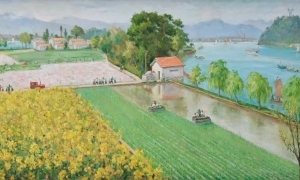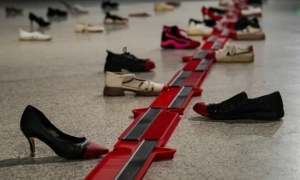武明中是近年来颇受关注的重要艺术家之一。他从自身脆弱的情感体验中,偶然发现了作为表现媒介的玻璃与人的心理之间关系,经过观念化转换,形成了一种新的艺术语言——脆弱性和透明性。这种语言构成了武明中绘画的美学核心,既折射出对人的脆弱心理学的分析,又表现出透明社会学的指涉意义。如果说前者更多产生的是个人化的视知觉感受,那么后者则更多强调的是对社会系统的剖析。
近来,他更偏向于对透明性意义的追问,他主观性地延伸了玻璃透明性蕴涵的直接或间接的指涉意义,它与民主、自由、监督、公开、公共性、交往性等有着内在联系,恰恰是透明性的合理存在,才对社会起到一场外科手术的作用——舆论、监督与强制性,也正是通过媒体中介和思想调节来揭示和清除由独裁、操纵、阴谋、罪恶、隐蔽、腐败构成的邪恶根源。实际上,武明中把透明性延展到坚强与脆弱、虚假与真实的对立关系中,清晰地传递出这种对立信息——矛盾与冲突、固定与易碎、坚强与脆弱、自由与独裁、正义与阴谋、善良与邪恶等较量的关系。这些都归结于他把绘画语言处理得更机巧和富有张力。
武明中的绘画具有某种混杂性的特质,也就难以界定其风格的属性,这无疑代表了进入21世纪新绘画的一种情绪。
Fake Authenticity
Wu Mingzhong Solo Exhibition
Curator: Huang Du
Wu Mingzhong is one of most important and influential artist in recent years. From his fragile emotional experiences, he has stumbled upon glass as a medium to reflect human psychological relationships, and he has transformed that concept into a new artistic language - a language of fragility and transparency. This language has become the aesthetic core of Wu Mingzhong’s painting, not only reflecting an analysis of people’s fragile psychology, but also presenting the implications of a transparent sociology. If we say that the former evokes more personalized feelings on visual perception, then the latter is more emphatic on the analysis of social systems.
Recently, he has also tended to explore the significance of transparency. Subjectively, he has further extended the direct or indirect implications of transparent glass, which has associations with democracy, freedom, supervision, openness, commonality and affiliation. A reasonably efficient transparency becomes a surgical tool for the community as public opinion, supervision and mandatory rules both disclose and eliminate the infectious roots of dictatorship, manipulation, conspiracy, crime, concealment and corruption. In fact, Wu Mingzhong has expanded transparency to include a contrast of opposites, qualities such as hardness and fragility, as well as fakeness and authenticity. His paintings have clearly developed these contrasts - contradiction and conflict, solidity and brittleness, hardness and fragility, freedom and dictatorship, justice and conspiracy, kindness and evil - and they come as the result of his ingenious and dynamic handling of an artistic language.
Wu Mingzhong’s painting constitutes a blend of idiosyncracies, so it is difficult to clearly define all its stylistic attributes, but his work undoubtedly represents a new mood in painting in the early years of the 21st century.
【编辑:霍春常】





















